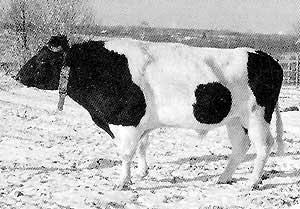Type the name of the breed you're looking for below
[wpdreams_ajaxsearchlite] Don't see the breed your're looking for? Click here and let us know!
Kholmogory cattle
| Place of Origin | Russia |
| Origin | The Kholmogory breed was formed in Kholmogory and Archangel districts of Archangel region. It is the oldest and one of the best breeds in the country. Even in the 17th century Kholmogory cattle were noted for their fast rate of growth and high milk production. The development of cattle breeding in the alluvial plain of the Severnaya Dvina river was aided by the available flood plain meadows and pastures with legume-grass mixtures. Excellent pastures in the summer and liberal feeding with high quality hay in winter were the bases for developing such valuable characteristics as the large size, harmonious conformation and high productivity. The local residents attached much importance to the correct methods of raising the young stock by hand nursing not by suckling; they used special methods of feeding, management and milking of the cows. The first selection of the animals was performed by the Kholmogory peasants as far back as 250 years ago. A considerable economic outlet for the Russian cattle products (butter, beef, tallow, leather) in Europe in the 17th and 18th centuries gave a new impetus to the local peasants to develop dairy and beef cattle breeding. According to the available historical data the Kholmogory breed had been formed long before foreign cattle were imported into Archangel and the adjacent areas. Kholmogory cattle had been exported beyond the boundaries of their initial habitat in 1693, 1713 and 1728 before they were crossed with foreign breeds. Highly productive Kholmogory cattle were used in various parts of the country for improvement of the local cattle. This intensive export resulted in the decline of the Kholmogory cattle husbandry. First attempts to improve the local Kholmogory cattle by crossing with the Dutch breed were undertaken in 1725, but there are no data available on the numbers of the imported cattle and their influence on the local cattle breeding. During 1765-1898 cattle from the Netherlands and from Holstein were imported in small numbers into Archangel province. According to Reznikov during that period 137 head of cattle, including 62 bulls, were imported. Nevertheless, the proportion of imported Dutch cattle was very low: in Kholmogory and Archangel districts the cattle population varied at that period from 19 to 23 000; the percentage of cows varied from 52.3 to 72.3. It is difficult to define how great the influence of the imported sires on the Kholmogory cattle was. In a monograph entitled "Kholmogory cattle" by A.A. Vityugov (Archangel 1928) and in the work by F.I. Reznikov under the title "New Data on the History of the Kholmogory Cattle" (Archangel 1949) it was stressed that the influence of foreign breeds on Kholmogorys was slight. Studies of Kholmogory cattle in 1911-12 (A.A. Kalantar) and in 1921-24 (A.A. Vityugov) showed that there are several basic and transitional types within the breed. They differ in conformation and productivity. In 1913-14 inspecting associations, cooperative dairy plants and mating stations were set up in the breeding zone of the Kholmogory cattle. The National Herdbook of the Kholmogory breed was started in 1927; in 1934 the state breeding station was established. They assisted in the breeding work with Kholmogory cattle by classification and selection of the animals, control of the raising of the replacement young stock, and identification of valuable animals. In 1936-37 on some farms a single cross with sires of the East Friesian breed was used to improve milk yield and conformation. The butterfat content of the crosses was considerably lower than that of their purebred Kholmogory parents; therefore crossbreeding was halted and the crosses were deported from the principal breeding zones of Kholmogory cattle. Good acclimatization of the Kholmogory cattle in various parts of the country encouraged their distribution to many republics, areas and regions. At present Kholmogory cattle are bred in 24 regions and republics, mainly in Archangel, Vologda, Kirov, Moscow, Kalinin, Ryazan, Kaluga, Kamchatka regions and in the Komi, Yakut, Tatar and Udmurt ASSRS. Each region or republic has its own specific climatic and feed conditions. The Kholmogory cattle are well adapted in those different geographical areas and show high milk production and such qualities as early maturity, hardiness, strong constitution and resistance to disease. In milk production, among the national cattle breeds the Kholmogory cattle are second after the Black Pied. Kholmogorys are not as productive as the imported breeds but the main reason for this is the low level of feeding and management and insufficiently intense selection and use of sires. In each region where the Kholmogorys are bred there are outstanding animals which are the founders of the lines, related groups and progenies. These animals should be used for pedigree activities on a wide scale. By the beginning of 1980 the total population of Kholmogory cattle was 2407000. |
| Purpose | Beef and dairy. |
| Appearance | The constitution of these cattle is strong and conformation is compact. The prevailing colour is black-and-white; less frequently it is black, red-and-white or solid red. These cattle are large; the legs of the cows are upstanding and the body is long. The head is refined and of medium size. The neck is thin. The chest is deep but not wide enough, with a small dewlap. The back and loin are level. The rump is wide, slightly raised. The hindquarters are wide. The skeleton is well developed. The legs are correctly set. The udder is medium in size; most cows have an udder with equally developed quarters. The teats are usually cylindrical. The hide is medium thick and elastic. The muscle development is satisfactory. |
| Horns | Short horns or polled (hornless) |
| Cows Average Weight | 499 - 680 kg (1100 - 1500 lbs.) |
| Bulls Average Weight | 816 - 1043 kg (1,800 - 2,300 lbs.) |



